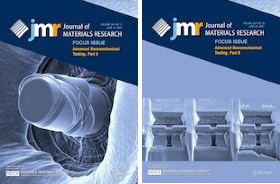Focus Issue on Advanced Nanomechanical Testing
A focus issue on advanced nanomechanical testing has recently been published in Journal of Materials Research (JMR) under the auspices of the Materials Research Society (MRS).
Benoit Merle acted as guest editor, together with Verena Maier-Kiener (MU Leoben), Timothy Rupert (UC Irvine) and George Pharr (Texas A&M).
The cover images were provided by Sebastian Krauß and Stefan Gabel.
Due to the large number of contributions, the special issue has been split between two journal issues, which are accessible for free through the following links (valid until September 6, 2021):
Scope of the focus issue
Small-scale mechanical characterization is essential for ensuring the service, performance, and lifetime of microscopic components, such as thin films and coatings, electronic sensors and MEMS. The first mechanical measurements on the submicrometer scale were enabled by the development of nanoindentation in the 1980s and early 1990s.
Nanoindentation has been considered the reference small-scale mechanical characterization method for almost 30 years. Its robustness has been repeatedly proven on a wide range of materials. In 2002, it became the first and, to date, the only nanomechanical testing method sanctioned with an ISO norm (ISO:14577). Still, a non-negligible number of the contributions to the JMR Focus Issue on Advanced Nanomechanical Testing are devoted to further improving its reliability, based on emerging technologies. These include more accurate imaging and faster data processing, which, for example, allow for improved characterization of the geometry of the indenter tip and the resulting contact area. In addition, the issue documents new method developments, which aim at further expanding the capabilities of nanoindentation beyond the measurement of hardness and Young’s modulus, i.e. accessing the local creep properties, ductility and surface free energy of materials.
Most current developments aim at deriving benefits from the latest advancements in data acquisition, data processing, as well as the new environmental capabilities of nanoindentation hardware. The overarching goals are to improve the statistical significance of the results and to reproduce the extreme environments that are responsible for the failure of many systems. The work collected in the Focus Issue presents a diverse perspective of the challenges and opportunities offered at the frontiers of nanomechanical testing, which we hope demonstrate to the reader the exciting future of this topic.
Find an interview between JMR Editor-in-Chief Gary Messing and guest editor Benoit Merle about the Focus Issue!
